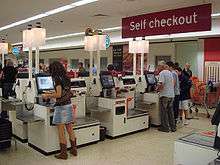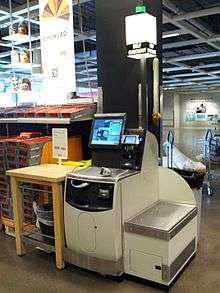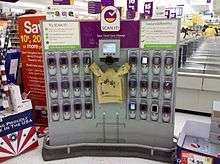Self-checkout


Self-checkout (also known as self-service checkout and as semi-attended customer-activated terminal, SACAT) machines provide a mechanism for customers to process their own purchases from a retailer. They are an alternative to the traditional cashier-staffed checkout. The customer performs the job of the cashier themselves, by scanning and applying payment for the items.
As of 2013, there were 191,000 self-checkout units worldwide, and the number was estimated to reach 325,000 units by 2019.[1] The machines were invented by David R. Humble.[2][3]
In self-checkout systems, the customer is required to:
- scan the barcodes;
- input the types of items such as fruit and vegetable (usually with a touchscreen display);
- weigh them, if applicable;
- and place all scanned items into a "bagging area". The weight observed in the bagging area is verified against previously stored information to ensure that the correct item is bagged, allowing the customer to proceed only if the observed and expected weights match.[4]
Payment by various methods may be accepted by the machines: card via EFTPOS, debit/credit cards, electronic food assistance cards, cash via coin slot and bank note scanner, and in-store gift cards where applicable. Most coupons also have barcodes and can be scanned the same way that items are scanned, although some require entry by a member of staff.
Advantages
The benefit to the retailer in providing self-checkout machines is in reduced labour costs: one attendant can often run four to six checkout lanes with the work of the cashier now being assumed by the customer. The size of a self-checkout machine is also smaller than a traditional checkout manned by a cashier; thus, a store can save space, which could be used for more shelves, display cabinets or additional checkouts.
Customers who do not want to interact with the cashier can use the self-checkout.
Self-checkout can also sometimes be faster than using a cashier lane. This can reduce the length of checkout lines (British: queues) and wait times.[5] In a survey by NCR, 42% of customers said they liked the convenience of self-checkout, while 39% said it was faster than the cashier-assisted line. 90% of those surveyed responded as being users of self-checkout, with 7% of respondents saying they will always use self-checkout regardless of store lines and number of items. Survey respondents in Italy and Australia said they "always use self-checkout" at a rate of 13% and 9% respectively.[1]
One advantage is that self-checkouts can, if the necessary investment is made, provide a partly multilingual service. (It cannot be fully bilingual unless the goods are labelled in all the relevant languages, which is often not the case.) For example, Tesco's Welsh stores which can serve customers in Welsh,[6] whereas finding enough fluent Welsh-speakers as staff can be difficult because in some areas only a small proportion of local people have Welsh as their first language.[7]
Disadvantages
Shoplifting

Self-checkout is vulnerable to some shoplifting techniques. In some cases the machine will pick up the attempt to steal, or cause the shopper to alter their behavior (e.g. an item can be put not on the scales but somewhere else where it should not be put, and this may be noticed by the system supervisor). For example, in 2007, a man was charged with replacing the tag of a plasma TV with a $4.88 DVD, and trying to purchase it through self-checkout.[8]
Studies suggest that a large proportion of shoppers are tempted to shoplift due to the relative ease of fooling self-checkouts. For example, a person who (initially without intent to steal) does not scan an item, may remember that this was easy, and fail to scan other items deliberately.[9] A 2012 survey with 4,952 respondents in the UK found that a third of shoppers had stolen this way, with around a quarter of the remainder stating they were deterred by the risk of detection. Non-barcode items such as produce, and store staff overriding (or ignoring) checkout alerts, were singled out as vulnerabilities, and poverty was not seen as a major factor.[10] The founder of one store video surveillance system estimated that "Theft — intentional or not — is up to five times higher with self checkout than when cashiers are working", although behaviour of shoplifters is becoming well known, and stores are now better at shoplifting detection.[11] A 2014 survey in of 2,634 respondents confirmed the same general findings, but commented that the cost of additional theft was evidently seen as "tolerable" compared to the cost of other processes, such as manned checkouts, and harm due to poorer customer service arising from the slowness of manned versus automated checkouts.[9]
Customer effort
In 2002, a study was carried out where people with disabilities used self-checkout machines, and found that existing checkout machines were not designed for accessibility.[12]
Customer interaction
Self-checkouts are also criticized for reducing the possibilities for customers and store staff to interact, and adversely affecting customer service in general.[11] Self-checkout lanes may lack some rather basic customer interactions, like informing the customer that a coupon was not accepted, and why.
Low reliability
Being more complex, self-checkouts are more prone to failure. For example, they use scales to weigh goods in the bagging area, and if the scale fails, the machine does not work. Also, in a manned checkout lane, any simple problems like lack of receipt paper would be immediately fixed by the operator, while self-checkouts may not be fixed for quite some time. This lack of reliability can be compensated for by having excess lanes available or enough staff on hand to perform immediate maintenance.
Scanning while shopping

An alternative system (self-scanning) consists of a portable barcode scanner that is used by the customer to scan and bag items while shopping.[13] When the customer has finished shopping, the scanner is brought to a checkout kiosk, where the information from the barcode scanner is downloaded to the kiosk, usually in conjunction with a customer loyalty card. The customer pays and receives a receipt at the checkout kiosk. The integrity of the system is maintained through the use of random audits or RFID. Walmart owned warehouse club, Sam's Club allows customers to download an app and scan items into their cart using a mobile application.[14] In summer 2018, Walmart China launched its Wechat-based "Scan and Go" program, allowing customers to scan items into their carts without downloading another mobile app, while paying through Wechat Payment or Alipay. The "Scan and Go"program carried 30% of all payments made in Chinese stores, and even improved sales in certain markets by 10%.[15]
In December 2016, Amazon announced a bricks and mortar store in Seattle under the name Amazon Go, which uses a variety of cameras and sensors in order to see what customers are putting into their shopping bags.[16] The customers scan a QR code when they enter the store through a companion app, which is linked to their Amazon.com account.[17] When the customer exits the store, the items in their bag are automatically charged to the account.[18]
Hybrid systems

Suppliers like ITAB, NCR, Wincor-Nixdorf and others have manufactured hybrid checkout systems that allows the checkout counter to be switched between either a cashier operated mode or a customer self-service mode.[19][20]
HybridCheckout from PeoplePos has taken the hybrid concept further by allowing the cashier and customer to do parallel and simultaneous scanning. This is achieved by adding a customer scanning area next to the cashier scanning area. The HybridCheckout solution allows for an increased throughput and a combination of cashier operated scanning and customer self-service.[21]
Open systems
In 2010, the open-source-self-check project was announced. By using hardware and open source software, this library self-checkout system costs less than one-tenth of the commercial version.[22][23]
A Java based open source self check client for libraries, which has been used at the University of Oxford,[24] is also available under a GPL v3 license.[25]
Criticisms
BBC News reported in December 2009 on the rise of self-service tills and how error messages like 'unexpected item in the bagging area' are becoming part of the new shopping experience and even given rise to T-shirts bearing the slogan.[26]
Self-serving checkout counters drastically reduce the demand for low skilled workers, using technology to eliminate a key human player in the marketplace. The widespread implementation of self checkout services will result in a decrease in available jobs for low skilled checkout workers, some of whom have depended on such jobs for a living.
Regulation
An appeal court in California confirmed in September 2013 a bill banning sales of alcoholic beverages in self-service checkouts. The law requires alcohol only to be sold in face-to-face transactions with store clerks.[27]
See also
| Wikimedia Commons has media related to Self checkout. |
References
- 1 2 "SELF-CHECKOUT: A GLOBAL CONSUMER PERSPECTIVE" (PDF). NCR Whitepaper. Retrieved 20 December 2016.
- ↑ "Self-Checkout Reaches Critical Mass - LPM". losspreventionmedia.com.
- ↑ "Self-service distribution system".
- ↑ Daniella Miletic (22 April 2008). "A new way to shop — check it out for yourself". Melbourne: The Age. Retrieved 2 September 2008.
- ↑ "The Pros and Cons of Using Self-Checkouts - BusinessBee". BusinessBee. 7 August 2013. Retrieved 5 June 2016.
- ↑ Hosford, Paul. "Tesco is looking at introducing Irish-speaking self-service checkouts". Retrieved 28 August 2016.
- ↑ "Home Truths: the decline of the Welsh language". Retrieved 28 August 2016.
- ↑ Meg, Maco (29 June 2007). "Guy Switches Price Tag On Walmart Plasma TV, Tries To Buy It For KES423". tips@consumerist.com. Consumerist. Retrieved 3 April 2014.
- 1 2 Carter, Clare (31 January 2014). "Self-scan fail: Supermarkets lose billions as thieving customers help themselves". canberratimes.com.au. Fairfax Media. Retrieved 3 April 2014.
- ↑ How cheating at checkouts is turning us into a nation of self-service shoplifters - Daily Mail online, 26 April 2012
- 1 2 "Self-checkout lanes boost convenience, theft risk". USA Today. 8 April 2012. Retrieved 3 April 2014.
- ↑ Bajaj, Komal; Mirka, Gary A.; Sommerich, Carolyn M.; Khachatoorian, Haig (31 March 2006). "Evaluation of a Redesigned Self-Checkout Station for Wheelchair Users". Assistive Technology. 18 (1): 15–24. doi:10.1080/10400435.2006.10131903.
- ↑ Zimmerman, Ann (18 May 2011). "Check Out the Future of Shopping". Wall Street Journal. Retrieved 7 December 2016.
- ↑ Sozzi, Brian (22 September 2016). "Walmart's sam's club scan-and-go app may make cash registers obsolete". TheStreet. Retrieved 7 December 2016.
- ↑ "南方都市报:边逛边扫移动支付,沃尔玛推进门店升级,记者带你体验"扫码购"". www.oeeee.com. Retrieved 2018-09-23.
- ↑ Stevens, Laura; Safdar, Khadeeja (6 December 2016). "Amazon Working on Several Grocery-Store Formats, Could Open More Than 2,000 Locations". Wall Street Journal. Retrieved 7 December 2016.
- ↑ Wingfield, Nick (5 December 2016). "Amazon Moves to Cut Checkout Line, Promoting a Grab-and-Go Experience". The New York Times. Retrieved 7 December 2016.
- ↑ Garun, Natt (5 December 2016). "Amazon just launched a cashier-free convenience store". The Verge. Vox Media. Retrieved 7 December 2016.
- ↑ Barwick, Hamish. "Coles trials hybrid self-checkout system in Victoria". computerworld.com.au. IDG Communication. Retrieved 3 April 2014.
- ↑ "Wincor Nixdorf to present 'Always Open' checkout solution at NRF Big Show". kioskmarketplace.com. Networld Media Group. Retrieved 3 April 2014.
- ↑ "HybridCheckout". hybridcheckout.com. PeoplePos Ltd. Retrieved 3 April 2014.
- ↑ "open-source-self-check". google.com. Google Project Hosting. Retrieved 3 April 2014.
- ↑ "Self-Check Kiosk from Scratch: Iowa Librarian's Coding Skills Prove Valuable". Archived from the original on 11 May 2011.
- ↑ Oxford Developments at GAUG 2002 Archived from the original on 24 November 2012
- ↑ "Ceridwen Self Issue Client". ceridwen.com. Ceridwen Limited. Retrieved 3 April 2014.
- ↑ Winterman, Denise (9 December 2009). "The problem with self-service checkouts". BBC News. Retrieved 9 June 2013.
- ↑ Egelko, Bob (20 September 2013). "Alcohol can't be sold at self-checkout lines". sfgate.com. SFGate. Retrieved 3 April 2014.
Further reading
- Cunningham, Tessa (7 April 2011). "Unexpected item in the bagging area: a human!". London: dailymail.co.uk. Retrieved 12 April 2011.